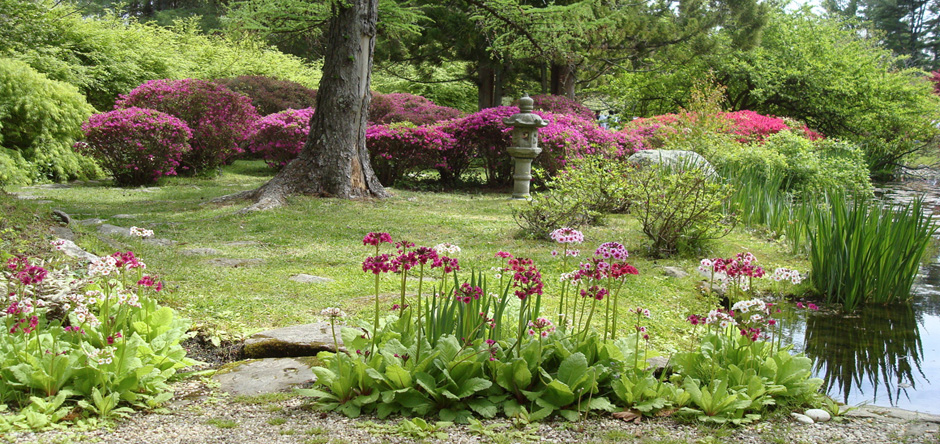Photography by L. Laken. Courtesy the Hammond Museum & Japanese Stroll Garden.
A garden is like speech: It will talk to any observant viewer who is also a good listener. A beautiful garden is the expression of a gardener with noble intentions and an imaginative sense of design. A good gardener selects worthy plantings, flowers and ornaments and arranges them in a meaningful way according to his or her own theory of gardening. Some prefer function over shapes or color over texture, but all hands-on gardeners are practical as well as creative. They check the pH of the soil, study the climate and investigate drainage problems, costs, time and maintenance.
On these counts, Western and Japanese gardens are much the same. But the languages the gardens speak are different. The words in Western gardens are mainly “beautiful flowers,” “blooms” and “shrubs,” while words in Japanese gardens include “stones,” “streams,” “shadows,” “trees” and “plants.” But in both, the sentences are formed by the system of arrangement that carries the message.
Most Western-style gardens are admired for their formal beauty. Their careful geometries celebrate the rational precision of their makers. The Japanese garden is no less structured than its Western counterpart. But its rhythms and patterns — reproducing and symbolizing those of the landscape in the world outside — are established in such a way as to disguise the human hand behind them. Garden stones and trees are laid out asymmetrically to suggest the rugged wildness of nature.
Nature, represented by manmade “micro-mountains” and “micro-lakes,” has been the main theme in Japanese gardens since the seventh century, and the same techniques are still used today. A helpful book for landscape gardeners called “A Japanese Touch for Your Garden” describes an inspirational miniature landscape garden only a few meters square: “The ‘mountain’ was a large stone. The ‘waterfall’ and the ‘stream’ were smaller stones carefully arranged in clefts and tiers. The ‘sea’ was of white gravel, and the ‘windswept trees’ were a few pines (bonsai) trained when they were young. The ‘hill’ was made with soil removed during contouring, and the ‘secluded temple’ was suggested by a stone tower from a local garden-supply store.
“But not once while looking at this scene did the man say to himself, ‘This is just a garden.’ What he saw was a landscape: alive, unsullied, vast and serene. It prepared him for his day beyond the garden wall.”
Gray, green and brown usually predominate in a Japanese garden, a counterpoint to scattered flowers and fruits that mark time’s passage with cycles of change. Empty space, wind, periods of dormancy, shadows and viewing angles are subtler in Japanese gardens. Contrast is important. A whole row of red flowers is never used, only a single red flower in a swell of green. Plants and blossoms, by their structure and poetry, suggest the fine melancholy experienced in nature. Manmade items like lanterns and tsukubai (Buddhist purifying basins) are used to humanize and decorate the garden.
Abstract renderings in solid stones that “live,” a winding path of pebbles and gravel, give the impression of moving water and provoke the mind with their union of seeming opposites (water and stone). Such dense interplays produce the effect of seeing nature whole, even though, in some cases, the garden may take up no more than a corner of a yard and consist only of bamboo, a shrub and a stone.
Many gardeners take the best from two schools of thought (once bitter enemies) — the formal and the informal, the symmetrical and the picturesque, the geometric and the natural, the classic and the romantic.
The origins of the gardens of Japan, of bonsai and of miniature landscape art were intimately connected with the greatest of Chinese arts, T’ang dynasty landscape painting, but they evolved into representing the landscapes of Japan itself — an island country, full of mountains, streams and tall trees.
Buddhist themes were explored, but at the heart of the gardens was the ancient Shinto faith, which viewed the world and everything in it within the primeval forces of creation.
Tea gardens also developed about this time to create the right mood of austerity for the tea ceremony. The values of Zen Buddhism and the tea ceremony have penetrated deeply into the Japanese sense of what is good and natural, and appropriate to the surroundings. To understand a Zen garden, you must know something of the myths and meanings that lie behind them before their richness and complexity becomes fully accessible.
Designing a garden is not an easy thing to discuss theoretically, for each problem brings its own special restrictions and each owner has a different set of tastes and requirements.
Style is a matter of taste. Design is a matter of principle. But everyone can listen to the language and silence of all good gardens.




